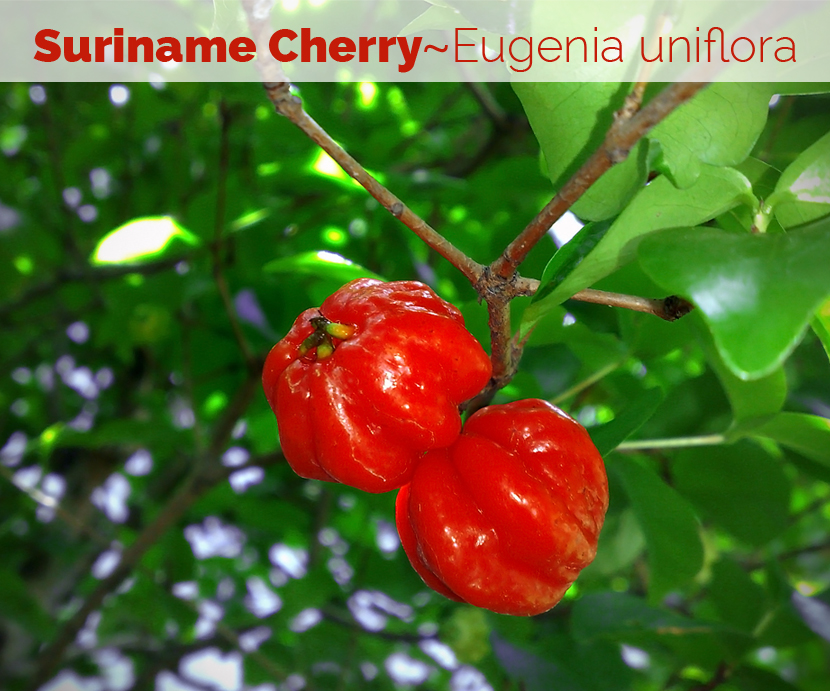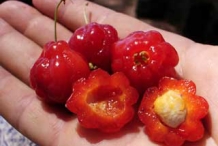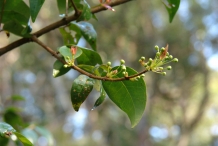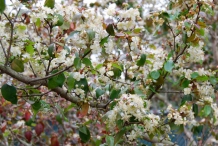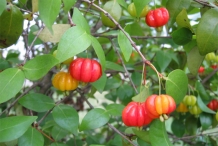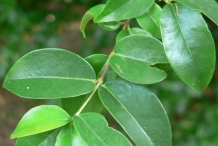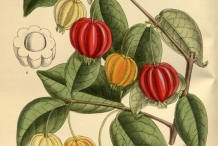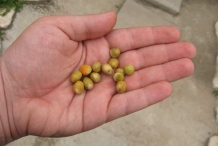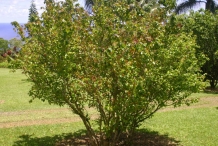History
Surinam Cherry found wild in Paraguay in the thickets on banks of Pilcomayo River. It was botanically described as a plant which grows in Pisa garden at Italy. It was believed to get introduced from Goa (India). The seeds were brought by the Portuguese voyagers to the India from Brazil.
It was naturalized in Argentina, Colombia and Venezuela. It is cultivated as an ornamental plant in Samoa, Hawaii, Ceylon and India. But it is occasionally grown in Southern China, tropical Africa and Philippines. Long ago, it was planted on the European Riviera and Mediterranean coast of Africa. Surinam cherry is considered as the hedge plants in the Florida. The tree was grown naturally in the past for its edible fruits. It was grown in the pots in the temperate zones.
Plant
Surinam Cherry is an evergreen, multi-branched shrub or small tree reaching 10 m (30 ft.) in height. The leaves are opposite, simple, pinnate, ovate or elliptic to ovate, shiny dark green and 2.5-8 cm (1-3 inch) long. The flowers have four white petals, thin, obovate, fugacious, fragrant and 13 mm (0.5 inch) across. The fruit is depressed to globose; 4 cm (1.5 inch) wide and 1 inch diameter. The fruit flesh is orange to red. Fruit possess 2 or 3 small seeds and light brown.
Nutritional Value
The serving size of 173 grams of raw Surinam Cherry provides 157.1 g of moisture, 57 calories, 1.38 g of protein, 0.69 g of total fat, 0.86 g of ash and 12.96 g of carbohydrate. The same amount provides 50.56% of Vitamin C, 18.57% of Vitamin A, 9.97% of Carbohydrate, 5.31% of Vitamin B2 and 5% of Magnesium.
Health Benefits of Surinam Cherry
Surinam Cherry is rich in antioxidants which help to prevent the free radicals that are the major cause for inflammation and diseases. Fruits are rich in phosphorus, Vitamin C, riboflavin, iron and niacin. It possesses antiseptic, antitumor, astringent and antibacterial properties; provide relief from diarrhea and gastro-intestinal problems.
- Heart ailments
The sufficient level of Vitamin C in Surinam Cherry helps to prevent the damage of blood vessels caused by free radicals. Atherosclerosis is a heart disease which is caused due to the free radicals. Vitamin C helps to prevent this heart ailment and other cardiac issues.
- Treats cancer
The high intake of fruits and vegetables is associated to lower the chances of cancer. The studies shows that high intake of Vitamin C helps to lower the chances of mouth, lungs, throat, vocal chords, rectum, colon, esophagus and stomach cancer.
- Eye ailments
Cataracts are the visual related problems. The people with cataracts have shown the decrease level of Vitamin C. The high intake of Vitamin C raises the supply of blood to the ocular areas.
- Treats common cold
Vitamin C promotes the immune power which prevents coughs and colds. It stimulates the iron absorption and enhances the resistance power of the body against infection. It helps to counteract against viruses.
- Skin health
Vitamin A helps to eradicate the body from toxins and free radicals which damages the skin. It provides soft and supple skin by retaining the moisture, prevent dryness, keratinization and skin ailments such as psoriasis.
- Prevent acne
Vitamin A lowers the production of excess sebum and reduces the acne. It strengthen the skin tissues, enhances the health and skin vitality. It helps to maintain the mucus membranes and skin tissues. It eradicates the toxins from the body and cleans the system with its antioxidant properties.
- Immune power
Vitamin A enhances the immune power to fight against infections by raising lymphocytic responses against antigens. It provides the moisture to the mucus membranes to provide immune power and promotes the actions of white blood cells. It prevents the entering of body, counteracts the infections. It ensures the double core protection.
- Prevent Muscular Dystrophy
It helps to maintain the bones shape and its health. Vitamin A ensures the proper growth of muscles. It prevents the development of muscular dystrophy.
- Produces RBC
Vitamin B2 helps to produce antibodies and red blood cells in the humans. It helps to increase oxygenation and circulation to the organs of the body.
- Regulates growth and reproduction
Vitamin B2 ensures the proper development and growth of reproductive organs and body tissues growth such as connective tissues, skin, eyes, nervous system, mucous membranes and immune system. Additionally, it promotes the healthy nails, skin and hair.
Traditional uses of Surinam Cherry
- The leaves are considered as astringent, stomachic, febrifuge and tonic.
- The infusion is an aid for influenza, head colds, coughs, chest colds and fevers.
- The infusion is consumed before childbirth.
- The crushed plant is steeped in the boiling water which is used as a wash to ease irritated skin.
- The fruits help to lower blood pressure.
- The syrup helps to cure influenza.
- The infusion made from leaves helps to treat fever, stomach diseases, rheumatism and digestive tract disorders, yellow fever, hypertension and gout.
- It also helps to lower blood pressure, weight and used as diuretic.
- The plants are used to treat the health ailments such as coughs, dysentery, diabetes, inflammation and ringworm.
- The leaf infusion is used in Brazil as a febrifuge, stomachic and astringent.
- In Java, fruits are used to lower blood pressure.
- The leaves help to reduce blood cholesterol and uric acid levels.
- The bark is used to treat diarrhea, hypertension, gout, edema, gastrointestinal disorders and eye infections.
Precautions
- The bruised branches and leaves possess a spicy resinous fragrance which can lead to respiratory discomfort.
- The seeds are not consumed.
- The people who are allergic to Surinam Cherry should avoid its use.
How to Eat
- Ripe fruit is consumed raw.
- It can be cooked as jams.
- The leaves are a perfect substitute for tea.
- An unripe fruits are used to make chutneys and relishes.
- Fruit are used to make pies, sherbets, juices etc.
- The fruits are also used in the preparation of various food products.
- The fruits are used to flavor jams and jellies.
- It is added to the fruit cups, custard pudding, salads, and ice cream.
- They are also prepared as pickles.
- The juice is fermented into wine or vinegar and prepared as distilled liquor.
- The fruit is used as an ingredient in the jelly, pies and sauce.
References:
http://www.scielo.br/pdf/cta/v31n1/21.pdf
http://www.cabi.org/isc/datasheet/23099
http://theindianvegan.blogspot.com/2013/02/all-about-pitanga.html
https://en.wikipedia.org/wiki/Eugenia_uniflora
https://hort.purdue.edu/newcrop/morton/surinam_cherry.html
http://ntbg.org/plants/plant_details.php?plantid=5067
http://www.rarefruitclub.org.au/Level2/Pitanga.htm
https://books.google.com.np/books?id=uRHwlkQVS2QC&pg=PA621&lpg=PA621
Comments
| Pitanga Quick Facts | |
|---|---|
| Name: | Pitanga |
| Scientific Name: | Eugenia uniflora |
| Origin | Native to tropical South America (such as Brazil, Uruguay, Paraguay and Northern Argentina). It is widely cultivated in Tropical regions. |
| Colors | Orange-red (Fruit) |
| Shapes | Depressed to globose; Width: 4 cm (1.5 inch); Diameter: 1 inch (Fruit) |
| Flesh colors | Orange to red |
| Taste | Sweet to sour (Fruit) |
| Calories | 57 Kcal./cup |
| Major nutrients | Vitamin C (50.56%) Vitamin A (18.57%) Carbohydrate (9.97%) Vitamin B2 (5.31%) Magnesium (5.00%) |
| Health benefits | Heart ailments, Treats cancer, Eye ailments, Treats common cold, Skin health |
| More facts about Pitanga | |
| Rank | Scientific Name & (Common Name) |
|---|---|
| Kingdom | Plantae (Plants) |
| Subkingdom | Tracheobionta (Vascular plants) |
| Superdivision | Spermatophyta (Seed plants) |
| Division | Magnoliophyta (Flowering plants) |
| Class | Magnoliopsida (Dicotyledons) |
| Subclass | Rosidae |
| Order | Myrtales |
| Family | Myrtaceae (Myrtle family) |
| Genus | Eugenia L. (Stopper) |
| Species | Eugenia uniflora L. (Surinam cherry) |


